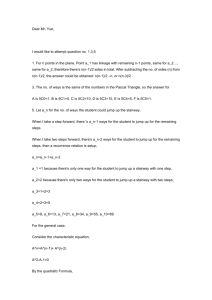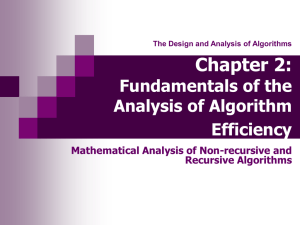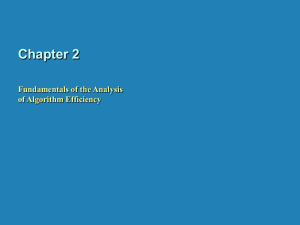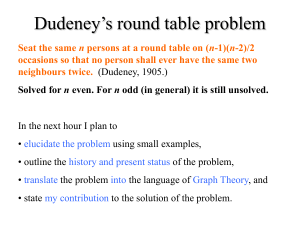Lec14AdvCounting05
advertisement
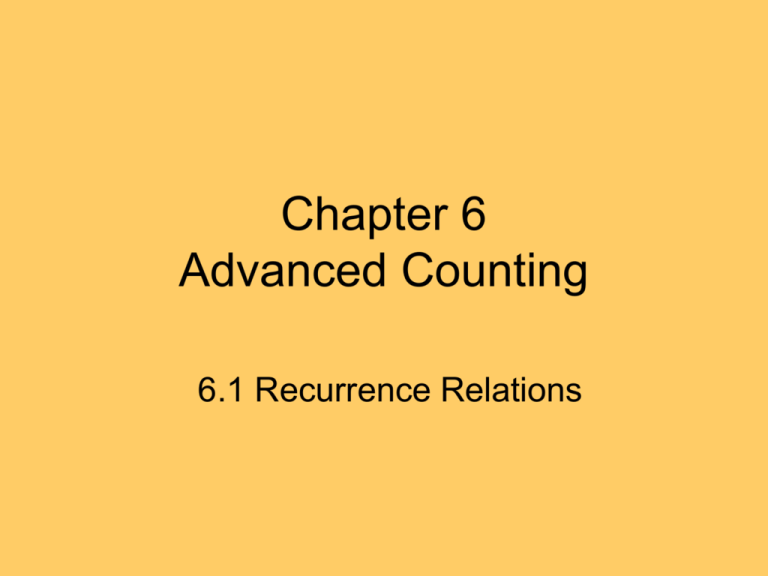
Chapter 6
Advanced Counting
6.1 Recurrence Relations
Recurrence Relations
Definition: An equation that expresses the element an of the sequence {an}
in terms of one or more previous terms of the sequence a0,...,an-1.
A sequence is a solution of the recurrence relation if its terms satisfy the
recurrence relation.
Example: Consider the recurrence relation an = 2a(n-1) –a(n-2), n in N
Consider the sequence: an=3n. Is it a solution?
2x3x(n-1)-3x(n-2) =3n YES! (a0 = 0, a1 = 3, a2 = 6,...)
Consider the sequence an=5. Is it a solution?
2x5 – 5 = 5 YES! (a0 = 5, a1 = 5, ...)
we see that to sequences can be a solution of the same recurrence relation
since the initial conditions are also very important.
The initial conditions plus the recurrence relation provide a unique recursive
definition of a sequence.
Modelling
Let’s say you put $1 dollar in the bank now. How much will you
receive in 50 years if the interest is 4%?
B(0) = 1.
B(n) = B(n-1) + 0.04xB(n-1)
= 1.04 x B(n-1).
= 1.04^2 B(n-2)
= 1.04^50 B(0)
= $ 7.1
(add the interest).
Tower of Hanoi
How many moves does it take to solve the Hanoi puzzle?
Let Hn be the number of moves to solve
a problem with n disks.
-We first move the top n-1 disks to peg 2
in H(n-1) moves.
-We then move the largest disk to peg 3 in
1 move.
-We then move the n-1 disks on top of the
largest disk in another H(n-1) moves:
Total: Hn = 2xH(n-1)+1
-Basis Step: 1 disk = 1 move: H(1)=1.
-Hn = 2(2H(n-2)+1)+1 = 2^2H(n-2)+2^1 + 1
....
=2^(n-1)H1 + 2^(n-2) + 2^(n-3)+...+2+1
=2^n-1 (by sums of geometric series 3.1).
Examples
How many bit-strings of length n with no consecutive 0’s?
an is number of bit-strings with no 2 consecutive 0’s in it.
How can we generate a bit-string of length n from bit-strings of length n-1?
Valid bit-strings fall into 2 classes, ones that end with a “0” and ones that end
with a “1”.
Ones that end in a “1” could be generated by adding a one to a valid bit-string
of any kind: a(n-1) ways.
Ones that end with a “0” came about by appending a smaller bit-string of length
n-1 that ended with a “1” (otherwise 2 zeros appear), which must have come
about in turn by appending a “1” to any valid bit-string of length n-2: a(n-2) ways.
Total: an = a(n-1) + a(n-2) n>2. a1 = 2, a2 = 3.
Recognize it? 2,3,5,8,13.....?
Catalan Numbers
In how many ways Cn can we put parentheses around n+1 symbols to indicate
in which order they should be processed?
Each string x0 x1 x2 ... xn is divided into 2 sub-strings: e.g. ((x0 x1) x2) (x3 x4)
Assume break occurs at after position k, then there are Ck x Cn-k-1 ways to put
parenthesis around the first & second sub-string.
Thus the total is: Cn = C0 Cn-1 + C1Cn-2+ ... +Cn-1C0 with C0=1 and C1 = 1.
n 1
Ck Cnk 1
k 0
number of extended
binary trees with n
internal nodes.
1 2n
n 1 n
(derivation later)
2
5
14



